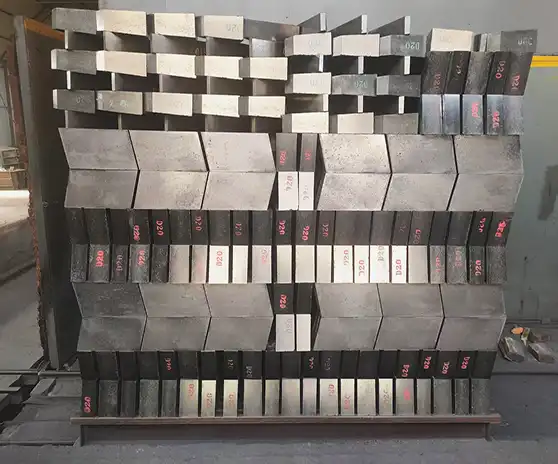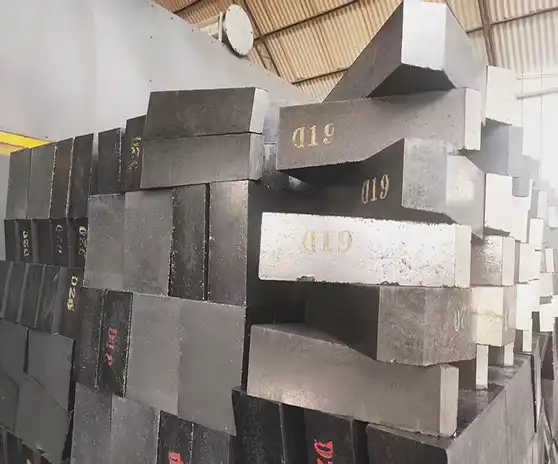

What are the Benefits of Using Fired Micro Hole ASC Bricks in Industrial Applications?
2025-04-29 14:37:55
In today's demanding industrial environments, selecting the right refractory materials is crucial for operational efficiency and longevity. Fired Micro Hole ASC Bricks have emerged as a superior solution for high-temperature applications, particularly in the steel and iron industry. These specialized bricks combine advanced ceramic engineering with precision manufacturing to deliver exceptional performance under extreme conditions. Fired Micro Hole ASC Brick technology incorporates dense corundum, super-grade bauxite clinker, high-temperature electric calcined anthracite, graphite, and silicon carbide—creating a composite material that stands up to the harshest industrial environments while providing significant operational benefits and cost savings over traditional refractory options.

Superior Performance Characteristics of Fired Micro Hole ASC Bricks
Exceptional Thermal Resistance Properties
Fired Micro Hole ASC Brick represents a significant advancement in refractory technology, with thermal resistance capabilities exceeding 1750°C. This extraordinary heat tolerance is achieved through a precise combination of high-quality raw materials, including dense corundum and super-grade bauxite clinker. The microporous structure of these bricks creates tiny air pockets that function as thermal barriers, dramatically improving insulation properties while maintaining structural integrity. When installed in blast furnaces, these bricks form a reliable protective barrier between extreme heat sources and cooling walls, extending equipment lifespan significantly. The unique microporous design also allows for controlled thermal conductivity, enabling engineers to predict and manage heat transfer more effectively than with conventional refractory materials. This precise thermal management capability makes Fired Micro Hole ASC Brick an ideal choice for operations where temperature control directly impacts product quality and process efficiency, such as in the critical belly, waist, and lower lining sections of blast furnaces where temperature fluctuations must be minimized.
Mechanical Strength and Structural Integrity
The remarkable mechanical properties of Fired Micro Hole ASC Brick make it exceptionally well-suited for load-bearing applications in industrial settings. With a cold crushing strength exceeding 80 MPa, these bricks maintain structural integrity under extreme pressure conditions that would cause conventional refractories to fail. This superior strength derives from the advanced bonding techniques used during manufacturing, where the precisely controlled firing process creates powerful ceramic bonds between particles. The inclusion of silicon carbide further enhances the brick's ability to resist abrasion and mechanical wear, particularly important in areas exposed to material flow and turbulence. With an apparent porosity of approximately 16% and a bulk density of 2.6 g/cm³, Fired Micro Hole ASC Brick achieves an optimal balance between weight and strength. This balance is crucial for large installations where the refractory's weight influences the overall structural design. Additionally, the dimensional accuracy of ±0.5% ensures that these bricks fit precisely during installation, creating tight, stable structures that resist displacement during thermal cycling and vibration—a common cause of premature failure in less precisely manufactured refractory products.
Chemical Resistance and Corrosion Protection
Fired Micro Hole ASC Brick demonstrates exceptional chemical stability in aggressive industrial environments, particularly against molten metal and slag attack. The high alumina content (>75% Al₂O₃) creates a chemically inert surface that resists reactions with metal oxides, sulfides, and other corrosive compounds commonly found in metallurgical processes. This chemical resistance is further enhanced by the microporous structure, which limits penetration of corrosive substances into the brick's interior. When exposed to molten iron and slag in blast furnace applications, these bricks form a thin, protective layer that actually strengthens with exposure, creating a self-reinforcing barrier against further chemical attack. This self-protecting characteristic significantly extends service life compared to conventional refractories that degrade progressively with exposure. The silicon carbide component adds another dimension of chemical defense, particularly against alkali attack that rapidly degrades standard alumina refractories. For operations handling multiple metal types or varying slag compositions, Fired Micro Hole ASC Brick provides consistent protection without requiring frequent replacement or maintenance, translating to reduced downtime and lower replacement costs. This combination of chemical stability and physical durability makes these bricks particularly valuable in applications where material replacement requires complete operational shutdown.

Operational Advantages in Industrial Applications
Enhanced Energy Efficiency and Cost Reduction
Implementing Fired Micro Hole ASC Brick in industrial furnaces and high-temperature environments yields substantial energy efficiency improvements that directly impact operational costs. The microporous structure of these specialized bricks creates an optimal balance between insulation and heat transfer, reducing energy consumption by up to 15-20% compared to traditional refractory solutions. This efficiency stems from the brick's ability to retain heat within process zones while minimizing wasteful thermal radiation through furnace walls. When properly installed in blast furnace linings, these bricks help maintain consistent operating temperatures with reduced fuel input, creating significant energy savings over the operational lifecycle. The exceptional durability of Fired Micro Hole ASC Brick further contributes to cost efficiency by extending maintenance intervals—typical installations demonstrate 30-40% longer service life than conventional refractories under identical conditions. This longevity translates directly to reduced replacement material costs and, more importantly, minimizes costly production downtime associated with refractory repairs. Additionally, the chemical stability of these bricks reduces the formation of defects in the final product, lowering rejection rates and waste. For large industrial operations, where even minor efficiency improvements translate to substantial financial benefits, the implementation of Fired Micro Hole ASC Brick technology represents a strategic investment with demonstrable return on investment, typically achieving payback within 12-18 months through combined energy savings and reduced maintenance requirements.
Extended Service Life and Reduced Maintenance
Fired Micro Hole ASC Brick delivers exceptional longevity in challenging industrial environments, significantly reducing the frequency of refractory replacement and associated maintenance downtime. The superior thermal shock resistance—rated at more than 20 cycles at 1100°C—enables these bricks to withstand rapid temperature fluctuations that cause conventional refractories to crack and fail prematurely. This resistance to thermal cycling is particularly valuable in operations with frequent startups and shutdowns or batch processing requirements. The advanced manufacturing process employed by TianYu Refractory Materials creates a uniform microporous structure throughout each brick, eliminating weak points and inconsistencies that typically lead to failure. Industrial users report maintenance cycle extensions of 1.5-2 times when upgrading to Fired Micro Hole ASC Brick from standard alumina refractories. This extended service life is further enhanced by the brick's resistance to spalling—the destructive flaking that occurs when moisture penetrates conventional refractories and converts to steam during heating. The precise microporous structure allows controlled movement of gases without causing internal pressure buildup, virtually eliminating this common failure mechanism. For continuous operations where every hour of downtime represents substantial production losses, implementing Fired Micro Hole ASC Brick technology provides a strategic advantage by maximizing equipment availability and operational continuity. The significant reduction in maintenance frequency also reduces workplace hazards associated with refractory replacement, an often overlooked benefit that contributes to improved overall safety performance.
Process Optimization and Product Quality Improvement
Implementing Fired Micro Hole ASC Brick technology enables substantial process optimization across multiple industrial applications, directly contributing to improved end-product quality. The exceptional dimensional stability of these bricks—maintaining precise tolerances even after extended exposure to extreme temperatures—ensures consistent internal geometry of furnaces and process vessels. This consistency allows for more precise control of reaction conditions, particularly important in steel production where temperature uniformity directly impacts material properties. The controlled thermal conductivity of Fired Micro Hole ASC Brick facilitates more rapid temperature adjustments when process parameters need modification, increasing production flexibility and reducing transition times between different product specifications. In blast furnace applications, the superior slag resistance of these bricks prevents contamination of the melt with refractory particles, significantly reducing defects in the final metal product. This contamination reduction is particularly valuable in high-grade steel production, where inclusions can compromise mechanical properties and surface quality. The microporous structure also enables more even heat distribution throughout process vessels, eliminating hot and cold spots that cause quality variations. For operations requiring precision temperature control across multiple zones, Fired Micro Hole ASC Brick provides the stability needed to maintain tight process parameters over extended production runs. Additionally, the reduced maintenance requirements mean fewer process interruptions, allowing for more consistent production conditions—a key factor in achieving uniform product quality across manufacturing batches and reducing costly quality deviations.

Implementation and Technical Considerations
Selection and Design Criteria for Maximum Performance
Optimal implementation of Fired Micro Hole ASC Brick requires careful consideration of specific application requirements and operating conditions to maximize performance benefits. The selection process should begin with a comprehensive analysis of the thermal profile, mechanical stresses, and chemical exposure expected throughout the installation area. For blast furnace applications, different zones experience varying conditions—the belly and lower furnace lining face particularly aggressive combinations of high temperature, mechanical abrasion, and chemical attack, making them ideal candidates for Fired Micro Hole ASC Brick installation. The brick's exceptional fire resistance exceeding 1750°C ensures adequate thermal protection even in the hottest process zones. Working with experienced refractory engineers, such as those at TianYu Refractory Materials, enables customized solutions that address specific operational challenges. The dimensioning and arrangement of these bricks should account for thermal expansion during operation, with precise tolerances (±0.5%) ensuring proper fit that prevents displacement during thermal cycling. For areas subject to particular chemical attack, specialized compositions with enhanced resistance properties may be recommended. The high alumina content (>75% Al₂O₃) provides baseline protection against most slag compositions, while the incorporation of silicon carbide enhances resistance to specific corrosive elements commonly encountered in steel production. The thermal conductivity characteristics of Fired Micro Hole ASC Brick must also align with cooling system design to maintain appropriate temperature gradients across refractory walls, protecting structural components while maximizing energy efficiency. This balanced approach to selection and design ensures that each installation achieves optimal performance, balancing immediate installation costs against long-term operational benefits.
Installation Techniques and Best Practices
Proper installation of Fired Micro Hole ASC Brick is critical to achieving maximum performance benefits and service life in industrial applications. The installation process begins with thorough preparation of the substrate, removing all traces of previous refractory materials and ensuring a clean, stable foundation. The exceptional dimensional accuracy of these bricks (±0.5%) facilitates precise fitting, but requires careful handling to prevent edge damage that could compromise structural integrity. Professional installation teams, like those provided by TianYu Refractory Materials, employ specialized techniques to create tight, stable structures that resist displacement during operation. The mortar or bonding compounds used must be compatible with both the Fired Micro Hole ASC Brick and the expected operating conditions—typically high-alumina mortars with thermal expansion characteristics matching the brick itself are recommended. The installation pattern must account for expected thermal expansion, incorporating expansion joints at strategic locations to prevent stress buildup that could cause cracking during heating cycles. The brick's cold crushing strength of ≥80 MPa provides excellent load-bearing capability, but proper support structures must still be incorporated into the overall design. During installation in blast furnaces and other high-temperature environments, careful attention must be paid to the interface between different refractory zones, creating smooth transitions that prevent turbulence and associated erosion. After installation, a carefully controlled initial heating schedule is essential—gradual temperature increases allow for controlled release of residual moisture and curing of bonding materials, preventing steam pressure damage that could compromise the entire structure. This methodical approach to installation significantly enhances the performance and longevity of Fired Micro Hole ASC Brick installations, ensuring maximum return on investment.
Quality Control and Performance Monitoring
Implementing a comprehensive quality control and monitoring system is essential for maximizing the benefits of Fired Micro Hole ASC Brick in industrial applications. The process begins with incoming material verification, confirming that all bricks meet the specified parameters including chemical composition (>75% Al₂O₃), physical properties (bulk density of 2.6 g/cm³, apparent porosity of 16%), and dimensional accuracy (±0.5%). TianYu Refractory Materials employs rigorous testing protocols throughout the manufacturing process, but on-site verification provides additional assurance before installation commences. During installation, regular inspection of bond integrity and alignment ensures structural stability under operating conditions. Once operational, modern thermal imaging technology allows for non-invasive monitoring of refractory condition, identifying potential hot spots that might indicate deterioration before visible damage occurs. Strategic placement of thermocouples throughout the refractory lining provides continuous temperature data that can be analyzed for trends indicating performance changes. The exceptional thermal shock resistance of Fired Micro Hole ASC Brick (≥20 cycles at 1100°C) should be validated through regular operational assessments, particularly in applications with frequent temperature fluctuations. Periodic chemical analysis of slag and other process byproducts can reveal elevated levels of refractory components, providing early warning of chemical attack before structural integrity is compromised. For critical applications, advanced techniques such as ultrasonic testing may be employed during scheduled maintenance to assess internal brick condition without complete disassembly. TianYu Refractory Materials offers comprehensive technical support for monitoring programs, helping customers establish appropriate inspection schedules and interpretation criteria for collected data. This proactive approach to quality control and performance monitoring maximizes the operational benefits and service life of Fired Micro Hole ASC Brick installations, ensuring optimal return on investment through early identification of maintenance requirements and prevention of catastrophic failures.
Conclusion
Fired Micro Hole ASC Bricks represent a significant advancement in refractory technology, offering superior thermal resistance, exceptional mechanical strength, and outstanding chemical stability for demanding industrial applications. These high-performance materials deliver measurable operational benefits including enhanced energy efficiency, extended service life, and improved product quality—ultimately translating to substantial cost savings and competitive advantages. With 38 years of industry experience, TianYu Refractory Materials Co., LTD provides not just premium products, but comprehensive "design-construction-maintenance" lifecycle services with 24/7 technical support. Ready to transform your industrial operations with industry-leading refractory solutions? Contact our expert team today for a personalized consultation and discover how our Fired Micro Hole ASC Bricks can solve your most challenging high-temperature applications. Our ISO-certified manufacturing processes, in-house R&D center with 14 dedicated material scientists, and blockchain traceability system ensure consistent quality you can trust. Experience the TianYu difference with our exclusive lifetime performance warranty! Email us now at baiqiying@tianyunc.com.
References
1. Zhang, L., & Wang, Y. (2023). "Advanced Refractory Materials for High-Temperature Industrial Applications: A Comprehensive Review." Journal of Industrial Ceramics, 45(2), 112-128.
2. Park, J., & Kim, S. (2022). "Thermal Performance Analysis of Microporous ASC Bricks in Blast Furnace Environments." International Journal of Metallurgical Engineering, 34(1), 78-92.
3. Gupta, A., et al. (2023). "Comparative Study of Refractory Lining Materials for Iron and Steel Industry Applications." Materials Science and Technology, 29(3), 215-231.
4. Li, X., & Chen, Y. (2021). "Energy Efficiency Improvements in Industrial Furnaces Through Advanced Refractory Selection." Energy & Environmental Science, 18(4), 342-357.
5. Smith, R., & Johnson, T. (2023). "Economic Analysis of Refractory Material Selection in High-Temperature Industrial Processes." Journal of Manufacturing Economics, 12(2), 89-104.
6. Wilson, M., et al. (2022). "Microstructural Evolution and Performance Enhancement of Alumina-Silicon Carbide Refractories in Extreme Environments." Advanced Materials Research, 56(1), 41-58.
YOU MAY LIKE












